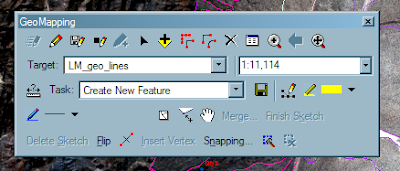The codes are based on terminology in the new digital geologic map standards published by the FGDC. The underlying scheme is based on one developed by Hastings and Sylvester. The seemingly overly detailed list is based on degrees of certainty relative to two aspects of lines on a geologic map: 1. What sort of line it is and how certain you are about that; and 2. How well the line's location is known.
Each funny looking code is a combination of the following characters that account for a variety of lines and a variety of degrees of certainty about what and where they are:
Line Types [kind]
- C Contact
- X Fault
- R Rock body (marker bed or key bed)
- Z Scarp (as feature, not contact)
- M Morphologic
- B Boundary
- g generic
- l landslide
- i internal
- f fluvial
- v volcanic
- s sedimentary
- z scarp
- d depression
- m morphologic feature
- c certain
- q questionable
- a accurate
- x approximate
- c concealed
- i inferred
- uB Boundary—undifferentiated
- mB Boundary—mapsheet
- pB Boundary—property
- sB Boundary—scratch
- wB Boundary—water
- eB Boundary—exclusion
- gCca Contact—Identity and existence certain, location accurate
- gCqa Contact—Identity or existence questionable, location accurate
- gCcx Contact—Identity and existence certain, location approximate
- gCqx Contact—Identity or existence questionable, location approximate
- gCci Contact—Identity and existence certain, location inferred
- gCqi Contact—Identity or existence questionable, location inferred
- iCca Internal contact—Identity and existence certain, location accurate
- iCqa Internal contact—Identity or existence questionable, location accurate
- iCcx Internal contact—Identity and existence certain, location approximate
- iCqx Internal contact—Identity or existence questionable, location approximate
- sCca Incised-scarp sedimentary contact—Identity and existence certain, location accurate.
- sCqa Incised-scarp sedimentary contact—Identity or existence questionable, location accurate.
- sCcx Incised-scarp sedimentary contact—Identity and existence certain, location approximate.
- sCqx Incised-scarp sedimentary contact—Identity or existence questionable, location approx.
- ldCca Sag-pond or closed depression on landslide (mapped to scale)
- viCca Contact separating individual lava flows within same map unit—Identity and existence certain, location accurate
- viCcx Contact separating individual lava flows within same map unit—Identity and existence certain, location approximate
- viCqx Contact separating individual lava flows within same map unit—Identity or existence questionable, location approximate
- gXca Fault (generic; vertical, subvertical, or high-angle; or unknown or unspecified orientation or sense of slip)—Identity and existence certain, location accurate
- gXqa Fault (generic; vertical, subvertical, or high-angle; or unknown or unspecified orientation or sense of slip)—Identity or existence questionable, location accurate
- gXqx Fault (generic; vertical, subvertical, or high-angle; or unknown or unspecified orientation or sense of slip)—Identity or existence questionable, location approximate
- gXcc Fault (generic; vertical, subvertical, or high-angle; or unknown or unspecified orientation or sense of slip)—Identity and existence certain, location concealed
- kRca Key bed—Identity and existence certain, location accurate
- kRcx Key bed—Identity and existence certain, location approximate
- fZca Fluvial terrace scarp—Identity and existence certain, location accurate. Hachures point down scarp
- fZqa Fluvial terrace scarp—Identity or existence questionable, location accurate. Hachures point down scarp
- fZcx Fluvial terrace scarp—Identity and existence certain, location approximate. Hachures point downscarp
- lZca Head or main scarp of landslide—Active, sharp, distinct, and accurately located. Hachures point down scarp
- lZcx Head or main scarp of landslide—Inactive, subdued, indistinct, and (or) approximately located. Hachures point down scarp
- liZca Internal or minor scarp in landslide—Active, sharp,distinct, and accurately located. Hachures point down scarp
- liZcx Internal or minor scarp in landslide—Inactive, subdued, indistinct, and (or) approximately located. Hachures point down scarp
- vMca Flow lobe or lava-flow front—Identity and existence certain, location accurate. Hachures on side of overlying younger flow
- vMqa Flow lobe or lava-flow front—Identity or existence questionable, location accurate. Hachures on side of overlying younger flow
- vMcx Flow lobe or lava-flow front—Identity and existence certain, location approximate. Hachures on side of overlying younger flow
- vMqa Flow lobe or lava-flow front—Identity or existence questionable, location approximate. Hachures onside of overlying younger flow
- vMm Crest line of pressure ridge or tumulus on lava flow



